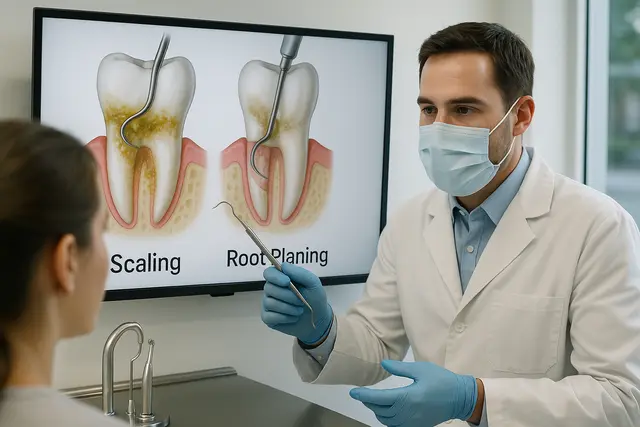General Dentistry
5 min read
Jul 07, 2025
Dental Treatment Plan Definition & Benefits: A Beginner’s Guide
Wondering what a dental treatment plan actually is, and why your dentist keeps bringing it up? You’re not alone. Whether you’re facing a cavity, gum issues, or just want to keep your smile in check, a treatment plan is your personalized game plan for better oral health.

If you’ve ever left the dentist’s office clutching a folder full of paperwork and wondering what half those terms meant, you’re not alone. That folder likely contained your dental treatment plan, and believe it or not, it’s not just paperwork. It’s a personalized roadmap for your mouth.
Whether you're dealing with toothaches, cavities, gum problems, or you're just trying to keep your smile in top shape, a treatment plan is the real MVP behind the scenes. So let’s break it all down and explore everything you need to know.
What Is a Dental Treatment Plan?
A treatment plan in dentistry is a comprehensive document that outlines exactly what’s going on with your teeth and gums, and what needs to happen next to fix, maintain, or enhance them.
Think of it like a blueprint for your oral health. It’s not just a random list of procedures. It’s carefully put together based on your dental condition, medical history, oral exam, x-rays, and any other diagnostics your dentist uses to understand what’s really going on under the surface.
A dental treatment plan usually includes things like a timeline, recommended treatment options, cost estimates, and the sequence of care. It’s personalized, strategic, and based on the wishes of the patient and what’s medically necessary. Whether it's a quick scale and polish or a multi-step restorative journey involving a crown, implant, or even a denture, it’s all laid out clearly so you’re never left in the dark.
Why Treatment Planning in Dentistry Matters
Treatment planning in dentistry isn’t just a paperwork requirement. It’s a key part of good patient care. It helps patients and providers align expectations, avoid surprises, and make well-informed choices. A good plan respects your time, your money, and your mouth.
Proper planning also helps dental practitioners spot complex cases early. That sharp tooth pain might not be “just sensitivity”, it could mean an endodontic issue or even something more advanced like periodontitis. With a solid plan in place, you get the appropriate care before things escalate into severe dental pain or costly emergencies.
Breaking Down the Phases of a Dental Treatment
Every comprehensive dental treatment plan is built on phases. These phases make it easier to track progress, manage budgets, and focus on priority areas without overwhelming you.
Here are the key treatment planning phases you’ll likely encounter:
Acute Phase
This is the dental “911” stage. If you’re in pain, have a lesion, or there’s an abscess from a pulpal or periapical infection, this is where the dentist focuses first. Emergency oral surgery, draining infections, or prescribing antibiotics fall into this category. It’s all about calming the storm before real work begins.
Control Phase
Next up: addressing active disease. This includes treating caries (cavities), cleaning up periodontal infections, and managing any pulpal issues. Think root canal treatment, fillings, hygiene instructions, and deep cleanings. This phase is all about disease control and stopping decay in its tracks.
Definitive Phase
Once your mouth is stable, it’s time for the heavy lifting, this is where you get your smile back. Whether it’s crowns, implants, restorations, orthodontic work, or even prosthodontics, this stage aims to rebuild and enhance function and appearance. It’s also where cosmetic procedures may be introduced, depending on your goals.
Maintenance Phase
Even the best dental work won’t last forever without upkeep. The maintenance phase involves regular checkups, cleanings, and monitoring of restorations to ensure your long-term oral health stays on track. This is also where you keep an eye on any tooth surface loss, signs of occlusal wear, or returning periodontal concerns.
Each phase of the treatment plan builds on the previous one. Rushing through or skipping steps isn’t just risky, it could undo all the hard work and money you’ve already invested.
Treatment Options and Patient Care: Tailoring the Plan
Let’s be real, everyone’s mouth is different. What works for one person might be totally wrong for someone else. That’s why treatment options are tailored to patient care needs, not just textbook recommendations.
If you’ve got complex dental issues, like failing restorations and missing teeth, your plan might include a combination of restorative, endodontic, and even prosthodontic solutions. Maybe you need a dental implant to replace a molar, a crown to protect a weak tooth surface, or a partial denture for wider restoration. The point is: your dentist isn’t throwing darts, they’re building a plan around you.
This approach helps patients achieve optimal oral health, even when balancing budget, time, and comfort. And hey, if you’re not ready to do everything at once, there’s usually a next phase you can schedule down the line.
The Role of Informed Consent in Dental Treatment Planning
No plan moves forward without informed consent. That’s not just a signature on a form, it’s a real conversation between dentist and patient. It means you understand what the plan involves, why it’s recommended, the risks of not proceeding, and what it’ll cost.
Too many patients skip this step or nod along without asking questions. Don’t. It’s your right to know exactly what’s being proposed and how it’ll impact your dental health and overall health.
Clear communication is a cornerstone of every trustworthy dental practice, and a quality treatment plan builds in space for your voice and concerns. Ask questions. Get second opinions if needed. Your comfort and trust are essential parts of the process.
Quadrant Dentistry and Efficient Care
Here’s a fun pro tip: ever heard of quadrant dentistry? It’s a smart way to group procedures by section of the mouth. Instead of fixing one caries on the left and coming back a week later for another on the right, your dentist may suggest tackling everything in one quadrant at a time. That means fewer appointments, less numbing, and better overall efficiency.
This approach fits neatly into larger treatment planning in dentistry and helps reduce disruption in your life while still maintaining high standards for patient care.
Digital Treatment Plans and Modern Dentistry
Today’s plans don’t just live on paper. Many dental practices now offer digital treatment plans that you can review at home. These often come with interactive diagrams, visual timelines, and even 3D scans so you can see your current oral health and progress toward your goals.
Digital tools make it easier for patients to stay engaged and informed. They also streamline communication with specialists, insurance companies, and caregivers involved in your health.
Final Thoughts: It’s More Than Just Teeth
A dental treatment plan isn’t just about teeth, it’s about overall health, patient management, and building a plan that works for your life. From the initial history and examination to diagnosis and treatment planning, your journey is shaped by expert strategy, compassion, and ongoing collaboration between you and your provider.
Whether you’re dealing with periodontitis, endodontic treatment, or just trying to maintain great oral hygiene, a strong treatment plan helps you achieve optimal oral health, not just for now, but for the future. So the next time your dentist pulls out a chart or mentions a control phase, don’t tune out. That’s the good stuff. That’s the plan that keeps your smile strong for the long haul.
What Is Included in a Dental Treatment Plan?
A dental treatment plan outlines everything your dentist recommends to restore, maintain, or enhance your oral health. It typically includes diagnoses, a sequence of proposed treatments, cost estimates, and a timeline. The plan is based on your medical history, exam findings, x-rays, and your personal goals. It’s designed to be customized, strategic, and easy to follow, so you always know what’s next for your smile.
Why Are Treatment Phases Important in Dentistry?
Treatment phases help organize care into manageable steps. The acute phase addresses urgent issues like infections or pain. The control phase targets active disease, such as cavities or gum problems. The definitive phase focuses on restoring function and appearance through crowns, implants, or orthodontics. Finally, the maintenance phase keeps everything stable with regular cleanings and checkups. Each phase builds on the last to ensure long-term success and minimize complications.
How Is a Treatment Plan Personalized for Each Patient?
Every treatment plan is tailored to a patient’s specific needs, oral health conditions, and goals. Your dentist considers factors like the severity of decay, missing teeth, gum health, budget, and personal preferences. Whether you need simple fillings or complex restorative work, the plan is built to fit your unique situation, not a one-size-fits-all approach. It’s also flexible, allowing adjustments based on comfort or timing.
What Is Informed Consent and Why Does It Matter?
Informed consent means you fully understand your treatment plan before anything begins. Your dentist explains the procedures, why they’re recommended, the risks of delaying or skipping treatment, and what to expect financially. It’s more than signing a form, it’s about making sure you feel informed, confident, and empowered to make decisions about your dental care. Clear communication is essential to building trust and successful outcomes.
Read Next
Related Posts

General Dentistry
How to Stop Nerve Pain in Tooth: Fast Relief That Works
Tooth nerve pain can be one of the most intense and disruptive types of discomfort. It often strikes without warning and makes everyday activities like eating, drinking, or even talking feel unbearable. Understanding what causes this pain and how to manage it effectively is key to getting fast relief.
4 min read
Sep 15, 2025

General Dentistry
Can a Sinus Infection Make Your Jaw Hurt? Understanding the Connection
Jaw pain can be unsettling, especially when it seems to appear out of nowhere alongside a stuffy nose or headache. Many people are surprised to learn that sinus infections can cause discomfort that feels like it’s coming from the jaw. Understanding the connection between your sinuses and jaw pain is key to getting the right treatment.
5 min read
Sep 15, 2025

General Dentistry
What Is SRP in Dentistry? A Complete Guide to Scaling and Root Planing
When it comes to dental health, most people think regular cleanings are enough to keep their smile safe. But sometimes, what’s happening below the gumline needs more attention. Scaling and root planing (SRP) is a treatment designed to address gum disease at its source, protecting both your gums and teeth from long-term damage.
5 min read
Sep 10, 2025
Don’t have time to research every dentist around you?
See why 30k+ patients trusted us